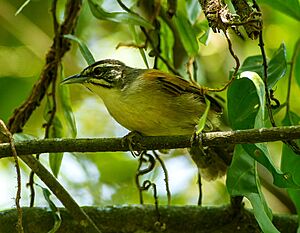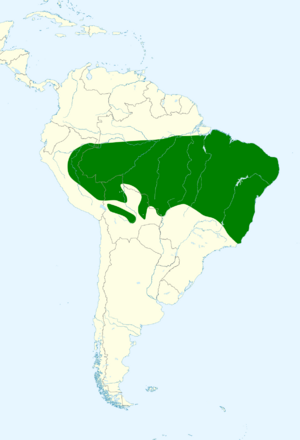Moustached wren facts for kids
Quick facts for kids Moustached wren |
|
|---|---|
 |
|
| Conservation status | |
| Scientific classification | |
| Genus: |
Pheugopedius
|
| Species: |
genibarbis
|
 |
|
| Synonyms | |
|
Thryothorus genibarbis |
|
The moustached wren (Pheugopedius genibarbis) is a small, lively bird that lives in parts of South America. You can find it in countries like Bolivia, Brazil, and Peru. It's known for the cool "mustache" markings on its face, which is how it got its name! This bird belongs to the Troglodytidae family, which are often called "true wrens."
Contents
About This Bird's Family
Scientists group living things into families to understand how they are related. The moustached wren is part of the wren family. Long ago, some people thought it was the same as the whiskered wren, but now we know they are different species.
There are four slightly different types, or subspecies, of the moustached wren:
- P. g. juruanus
- P. g. genibarbis
- P. g. intercedens
- P. g. bolivianus
What Does It Look Like?
The moustached wren is about 15.5 cm (6.1 in) long. That's about the length of a pen! It weighs between 16.2 to 22.8 g (0.57 to 0.80 oz), which is lighter than a few coins.
This bird has a grayish-brown head and neck. Its back and rump are a bright chestnut color. Its tail is dull brown with thin black stripes.
Look closely at its face! It has a white stripe above its eye and a white ring around its eye. A black stripe goes right through its eye. Its cheeks are gray-black with white streaks, and it has a clear white "mustache" stripe. Below that, there's a black stripe.
Its throat and upper chest are white. The lower chest is a light tan color, and its sides and belly are a deeper brown. Young moustached wrens look a bit different. Their heads are browner, and their backs are not as bright chestnut. Their face markings are also less clear.
Where Does It Live?
The moustached wren lives across the central and southern parts of the Amazon Basin. This huge area includes parts of Peru, Brazil, and Bolivia.
Each subspecies lives in a specific area:
- P. g. juruanus lives in eastern Brazil, from the Madeira River to the Atlantic coast.
- P. g. genibarbis is found in eastern Peru, western Brazil, and likely northern and western Bolivia.
- P. g. intercedens lives in central Brazil, in the states of Mato Grosso and Goiás.
- P. g. bolivianus is in the northern Santa Cruz Department of eastern Bolivia.
This bird likes to live at the edge of forests, especially near rivers. It often chooses places with thick stands of Bambusa bamboo plants. You can find it from sea level up to about 1,500 m (4,900 ft) high in Bolivia.
Behavior and Habits
What It Eats
The moustached wren usually looks for food low down in plants. It often forages in pairs. While scientists haven't fully studied its diet, they believe it mostly eats small creatures without backbones, like insects.
Reproduction and Life Cycle
Scientists have found four moustached wren nests in Peru's Manu National Park. These nests were shaped like a dome or a ball with an opening on the side. All the nests had four eggs inside. These eggs were found in September and October. It's thought that the female bird sits on the eggs to keep them warm. We don't know much more about how these birds raise their young.
Its Songs and Calls
Both male and female moustached wrens sing! Their song is described as "a series of fast rollicking phrases" [1]. They also have a call that sounds like "a whining 'jeeyr'".
Conservation Status
The IUCN (International Union for Conservation of Nature) has looked at the moustached wren. They have listed it as a species of "Least Concern." This means that the bird is quite common across its large habitat. Its home is widespread and not in too much danger. Plus, it lives in several protected areas, which helps keep it safe.


